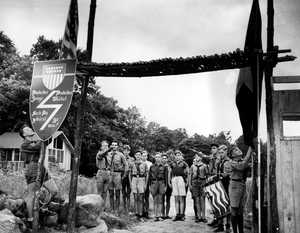Dorothy Thompson Is the Most Famous Female Journalist You've Never Heard Of
She made a name for herself by speaking out against fascism abroad and at home. Then the fight got personal.

On the morning of August 25, 1934, the American journalist Dorothy Thompson was taking breakfast in her room at the Hotel Adlon in Berlin when she received a letter from the Gestapo. “In view of your numerous anti-German publications in the American press,” Thompson was informed, “the German authorities, for reasons of national self respect, are unable to extend to you a further right of hospitality.”
The Reich bore her a distinct animus. For years, she had been critical of fascist movements throughout Europe. After being granted an interview with Hitler in 1931, Thompson wrote an especially unflattering portrayal of the soon-to-be German chancellor. That long essay, which first ran in Cosmopolitan Magazine, was subsequently turned into a book called I Saw Hitler. “He is formless, almost faceless,” Thompson had written, “a man whose countenance is a caricature, a man whose framework seems cartilaginous, without bones. He is inconsequent and voluble, ill-poised, insecure. He is the very prototype of the Little Man.” In addition to that injurious portrait, Thompson had produced a series of articles for the Jewish Daily Bulletin deploring Hitler’s anti-semitic policies.
The Führer was reportedly threatened enough by her work to demand the creation of a “Dorothy Thompson Emergency Squad” to rush translations of her articles. Now, at the personal directive of Hitler himself, she was being expelled from the country, an unprecedented act against an American correspondent.
A cadre of foreign journalists sent Thompson off, colleagues from her years as Central European Bureau chief for the New York Evening Post and Philadelphia Public Ledger. (She had been the first-ever woman appointed to the position, which oversaw foreign coverage for both newspapers, a decade earlier.) “Nearly the entire corps of American and British correspondents went to the railway station to see her off and wish her good luck,” the New York Times reported, adding that Thompson was presented with an armful of American Beauty roses as a gesture of admiration.
Far from silencing her, the expulsion only increased Thompson’s influence. The Times featured the story of her ban on the newspaper’s front page, and eagerly ran her reflections about it the following day. “My offense was to think that Hitler is just an ordinary man,” she wrote. “That is a crime against the reigning cult in Germany, which says Mr. Hitler is a Messiah sent by God to save the German people—an old Jewish idea.” Thompson closed her column in the Times with the kind of bon mot that had already propelled her to public renown: “To question this mystic mission is so heinous that, if you are a German, you can be sent to jail. I, fortunately, am an American, so I merely was sent to Paris. Worse things can happen to one.”

Upon her return to the United States, Thompson turned her indomitable energies toward denouncing fascism with every opportunity she was offered, and she was offered many. First came a 30-city lecture tour spanning the next year and a half. Then in 1935, NBC offered Thompson her own weekly radio show, allowing her to speak directly to tens of millions. The next year she began writing “On the Record,” a regular column with the New York Herald Tribune, that was syndicated to 150 other newspapers across the country, placing her opinions in front of millions more. She was eventually given a TIME magazine cover, where the accompanying profile called her and Eleanor Roosevelt “undoubtedly the most influential women in the U.S.”
Thompson leveraged all of these platforms to warn audiences about the dangers of totalitarianism—but not just in Europe. At home, she found cause for concern in the New Deal, with its wage- and price-setting, its massive public works projects and centralized power vested in the executive branch, all of which she feared could presage a slide into authoritarian rule. “What we are interested in is neither the dictatorial talents nor the dictatorial predilections of the President. We aren’t concerned with whether he wants too much power, but with whether he can get too much power.” In 1937, she testified before Congress about what she viewed as a slippery slope from consolidated federal control to fascism. “In country after country, under one slogan or another, the people are retreating from freedom,” Thompson told the Senate Judiciary Committee, “and voluntarily relinquishing liberty to force and authority.”
“Her point was this can happen anywhere,” University of London professor Sarah Churchwell told American Experience. “You have to strengthen your Democratic guardrails. You have to ensure that you don't let this happen to you because complacency is the enemy. And that is what she wrote about over and over and over again, banging the drum. Warning people, take this seriously. This isn’t a joke. And nobody is immune to it.” Thompson saw no conflict between her roles as a journalist and a staunch anti-fascist voice. “The function of journalism and a free press is not confined to the presentation of news,” she wrote. “Their function is to create continual debate, to provide a forum, to give opportunity for the expression of opinion.”

When it came to homegrown American Nazism, that expression involved significant personal risk. Thompson’s moment of direct action took place on February 20, 1939 at New York City’s Madison Square Garden. She was on her way to give a speech when she decided to join a convocation of 22,000 American Nazis hosted by the German American Bund, a pro-fascist organization with chapters across the country. The event had been planned to coincide with George Washington’s birthday, billed by the Bund as a “mass demonstration for true Americanism.”
Coverage in The Boston Globe the next day noted that the rally had “all the trappings of the spectacular mass assemblies familiar to Nazi Germany…Storm troopers strode the aisles. Military bands blared martial airs and German folk songs. Young and old Bund members paraded and drilled in the glare of blue spotlights. Arms snapped out in the Nazi salute.” The American flag hung side by side with the Nazi swastika and banners bearing messages such as “Stop Jewish Domination of Christian America.”
Thompson was seated in the front row of the press box, and during the evening’s speeches, began to laugh, loudly and disruptively. After being escorted out of the building by New York City police, she returned to her seat where she was surrounded by a dozen Bund stormtroopers. Thompson then proceeded to cause a second scene by shouting “bunk!” at the stage. “It may have been her finest moment,” wrote her biographer Peter Kurth, “the indelible dramatization of her promise to Hitler that she would not be muzzled by thugs.”
“I was amazed to see a duplicate of what I saw seven years ago in Germany,” she told a reporter after leaving the event. “Tonight I listened to words taken out of the mouth of Adolf Hitler.” It was precisely those words’ utterance at home that alarmed her most. She had spent a good part of her career watching how fascism could, improbable as it might first have seemed, sweep over a nation.
“No people ever recognize their dictator in advance,” Thompson wrote in a 1937 “On the Record” column, making the clearest case possible for constant vigilance. “He never stands for election on the platform of dictatorship. He always represents himself as the instrument for expressing the Incorporated National Will. When Americans think of dictators they always think of some foreign model. If anyone turned up here in a fur hat, boots and a grim look he would be recognized and shunned…But when our dictator turns up you can depend on it that he will be one of the boys, and he will stand for everything traditionally American.”









